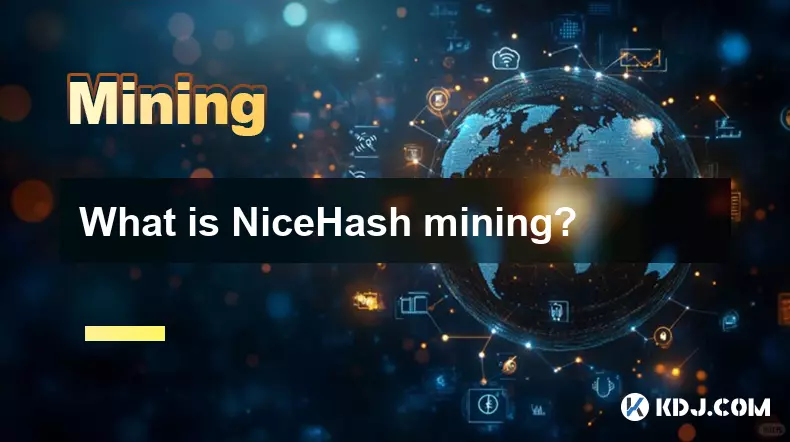-
 bitcoin
bitcoin $101752.865364 USD
-1.09% -
 ethereum
ethereum $3382.985899 USD
-1.38% -
 tether
tether $0.999658 USD
0.04% -
 xrp
xrp $2.272505 USD
-1.51% -
 bnb
bnb $989.089004 USD
0.14% -
 solana
solana $156.962612 USD
-3.08% -
 usd-coin
usd-coin $0.999776 USD
0.01% -
 tron
tron $0.290786 USD
-0.69% -
 dogecoin
dogecoin $0.174594 USD
-2.86% -
 cardano
cardano $0.560085 USD
-3.55% -
 hyperliquid
hyperliquid $40.023704 USD
-5.75% -
 chainlink
chainlink $15.324649 USD
-2.78% -
 bitcoin-cash
bitcoin-cash $493.576540 USD
-3.52% -
 zcash
zcash $571.320038 USD
-12.05% -
 stellar
stellar $0.280066 USD
-4.26%
The ultimate guide to crypto mining.
Cryptocurrency mining has evolved from CPU-based hobbyist efforts to industrial-scale ASIC operations, driven by rising competition and technological advances.
Nov 05, 2025 at 11:00 pm

The Evolution of Cryptocurrency Mining
1. In the early days of Bitcoin, mining could be done efficiently using standard desktop computers equipped with CPUs. The computational demands were low, allowing enthusiasts to participate without significant investment in hardware.
2. As network participation grew, miners began adopting GPUs due to their superior parallel processing capabilities. This shift marked the beginning of a more competitive landscape, where individual hobbyists started facing challenges from organized mining groups.
3. The introduction of Application-Specific Integrated Circuits (ASICs) revolutionized the industry. These devices are engineered solely for mining cryptocurrencies and offer unmatched efficiency and hash rates compared to general-purpose hardware.
4. Mining pools emerged as a response to increasing difficulty levels. By combining computing power, participants increase their chances of solving blocks and receiving proportional rewards, making mining accessible even for those with limited resources.
5. Geographic distribution of mining operations has shifted over time, influenced by electricity costs, regulatory environments, and climate conditions. Countries like China once dominated but have since faced restrictions, leading to relocation of operations to regions such as North America and Scandinavia.
Key Components of a Mining Setup
1. Selecting the right mining rig depends on the target cryptocurrency. For Bitcoin, ASIC miners like Bitmain’s Antminer series dominate the market. Ethereum mining prior to its transition favored high-memory GPUs such as NVIDIA’s RTX 30-series or AMD’s Radeon VII.
2. A reliable power supply unit (PSU) is critical. Mining hardware consumes substantial electricity, and an inadequate PSU can lead to system instability or hardware damage. Units rated at 80 Plus Gold or higher ensure energy efficiency and longevity.
3. Cooling infrastructure cannot be overlooked. Continuous operation generates heat, which degrades performance and shortens equipment lifespan. Proper ventilation, industrial fans, or immersion cooling systems help maintain optimal temperatures.
4. Internet connectivity must remain stable. While mining does not require high bandwidth, consistent uptime ensures that the miner stays synchronized with the blockchain network and does not miss block opportunities.
Failure to account for thermal management often results in premature hardware failure, significantly impacting profitability.Profitability and Economic Considerations
1. Electricity cost is the largest operational expense in mining. Locations with subsidized or renewable energy sources—such as hydroelectric plants in Iceland or excess natural gas in Texas—offer considerable advantages.
2. Mining calculators allow operators to estimate returns based on hash rate, power consumption, pool fees, and current coin prices. These tools provide insight into break-even timelines and help determine whether expansion is viable.
3. Hardware depreciation occurs rapidly due to technological advancements. A top-tier ASIC today may become obsolete within 18 months, necessitating reinvestment or replacement to remain competitive.
4. Market volatility directly affects revenue. A sudden drop in cryptocurrency value can turn a profitable operation into a loss-making one overnight, especially if fixed costs remain unchanged.
Miners who lock in long-term power contracts at favorable rates gain a structural edge over competitors exposed to fluctuating utility prices.Environmental and Regulatory Challenges
1. The carbon footprint of proof-of-work mining has drawn criticism from environmental groups. Some projects now emphasize use of stranded or flared energy to mitigate ecological impact.
2. Jurisdictions vary widely in their approach to crypto mining. While Kazakhstan welcomed miners with tax incentives, others like Iran have imposed temporary bans during periods of energy shortage.
3. Noise pollution from large-scale mining farms has led to community pushback in residential areas. Soundproofing enclosures and remote facility placement are common mitigation strategies.
4. Regulatory compliance includes proper business registration, adherence to electrical codes, and accurate reporting of income for tax purposes. Non-compliance risks fines or forced shutdowns.
Operators who proactively engage with local authorities and demonstrate sustainable practices improve their chances of long-term operational continuity.Frequently Asked Questions
What happens when a mining rig stops being profitable?Operators typically assess whether to continue running the device at a loss, repurpose it for alternative coins, or sell it for parts. Some decommission older units and reallocate capital toward newer, more efficient models.
Can home users still profit from mining?Yes, but only under specific conditions. Mining less competitive altcoins, leveraging low-cost electricity, or participating in pooled efforts increases the likelihood of modest gains. However, most consumer-grade setups struggle to cover overheads given current network difficulties.
Is cloud mining a viable alternative?Cloud mining allows individuals to rent hashing power without managing physical hardware. While convenient, many services have proven fraudulent or unprofitable after fees. Due diligence is essential before committing funds to any contract.
How do halving events affect miners?Bitcoin halvings reduce block rewards by 50%, cutting direct income from newly minted coins. Miners must rely more heavily on transaction fees and operate with tighter margins. Less efficient operators often exit the network following these events.
Disclaimer:info@kdj.com
The information provided is not trading advice. kdj.com does not assume any responsibility for any investments made based on the information provided in this article. Cryptocurrencies are highly volatile and it is highly recommended that you invest with caution after thorough research!
If you believe that the content used on this website infringes your copyright, please contact us immediately (info@kdj.com) and we will delete it promptly.
- Ripple (XRP) in 2026: Hold or Fold? A Look at XRP's Future and Emerging DeFi Alternatives
- 2025-11-08 18:35:01
- Zcash ZEC Coin Price Explosion: From Privacy Niche to Center Stage
- 2025-11-08 18:55:01
- Berachain Price Prediction: Navigating the Honeycomb Hype in Crypto
- 2025-11-08 18:55:01
- Arthur Hayes, Gold, and Bitcoin: A Modern Monetary Trinity?
- 2025-11-08 19:15:01
- Shiba Inu's Next Move: Navigating a Shifting Market
- 2025-11-08 19:20:01
- Pakistan's Crypto Crossroads: Balancing Opportunity with Asset-Backed Realities
- 2025-11-08 19:20:01
Related knowledge

What is the block reward in mining?
Nov 06,2025 at 12:35am
Understanding Block Rewards in Cryptocurrency Mining1. The block reward is the incentive miners receive for successfully validating and adding a new b...

How do mining algorithms work?
Nov 06,2025 at 04:59am
Mining Algorithms and Their Role in Blockchain Networks1. Mining algorithms serve as the backbone of blockchain consensus mechanisms, ensuring that tr...

What is NiceHash mining?
Nov 06,2025 at 07:40am
NiceHash mining refers to the process of renting out computational power to individuals or organizations seeking to mine cryptocurrencies without owni...

Does an antivirus program affect mining?
Nov 05,2025 at 09:29pm
Understanding Decentralized Exchanges in the Crypto Ecosystem1. Decentralized exchanges (DEXs) operate without a central authority, allowing users to ...

What is the history of Bitcoin mining?
Nov 05,2025 at 08:15pm
Within the fast-moving world of cryptocurrency, new developments emerge daily, reshaping how investors, developers, and institutions interact with dig...

How is the energy consumption of mining justified?
Nov 05,2025 at 10:20pm
Energy Consumption in Cryptocurrency Mining1. The energy consumption associated with cryptocurrency mining has drawn significant attention from enviro...

What is the block reward in mining?
Nov 06,2025 at 12:35am
Understanding Block Rewards in Cryptocurrency Mining1. The block reward is the incentive miners receive for successfully validating and adding a new b...

How do mining algorithms work?
Nov 06,2025 at 04:59am
Mining Algorithms and Their Role in Blockchain Networks1. Mining algorithms serve as the backbone of blockchain consensus mechanisms, ensuring that tr...

What is NiceHash mining?
Nov 06,2025 at 07:40am
NiceHash mining refers to the process of renting out computational power to individuals or organizations seeking to mine cryptocurrencies without owni...

Does an antivirus program affect mining?
Nov 05,2025 at 09:29pm
Understanding Decentralized Exchanges in the Crypto Ecosystem1. Decentralized exchanges (DEXs) operate without a central authority, allowing users to ...

What is the history of Bitcoin mining?
Nov 05,2025 at 08:15pm
Within the fast-moving world of cryptocurrency, new developments emerge daily, reshaping how investors, developers, and institutions interact with dig...

How is the energy consumption of mining justified?
Nov 05,2025 at 10:20pm
Energy Consumption in Cryptocurrency Mining1. The energy consumption associated with cryptocurrency mining has drawn significant attention from enviro...
See all articles





















![The Graph Price Prediction [GRT Crypto Price News Today] The Graph Price Prediction [GRT Crypto Price News Today]](/uploads/2025/11/07/cryptocurrencies-news/videos/690d4df44fe69_image_500_375.webp)




















































